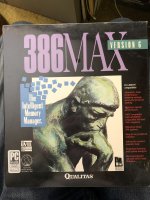When I started at Qualitas (386MAX) in 1990, a couple days after I started, the boss/owner (who I already knew as a friend) and another guy, came in my office and dropped a big box on my desk. It was like 10" tall box of 8-1/2 x 11 sheets. The doc from that Windows 3 DDK beta.
And they said "Make this work" (meaning the 386MAX features under Windows). <sigh>
And they said "Make this work" (meaning the 386MAX features under Windows). <sigh>

